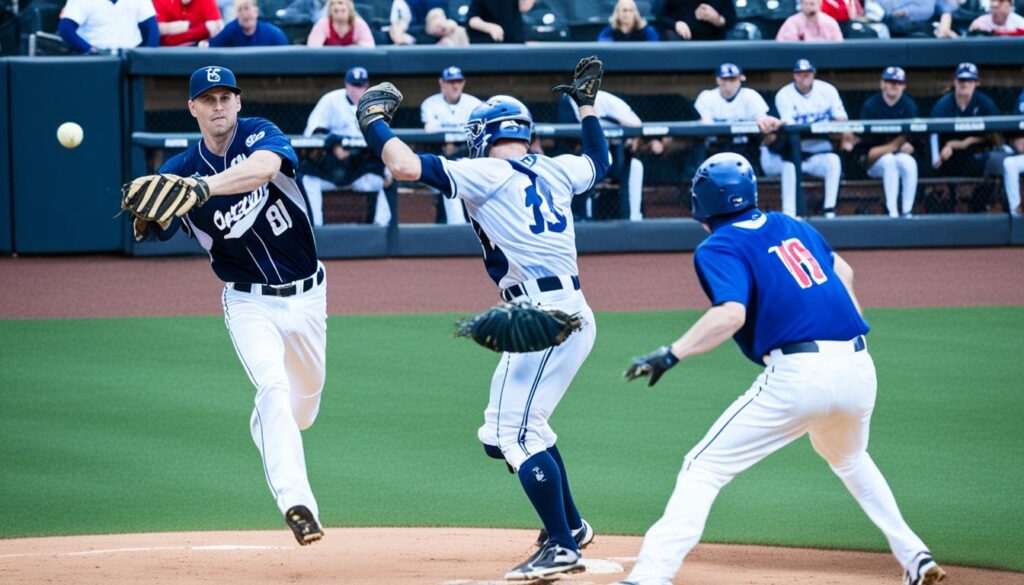
When it comes to evaluating a player’s offensive performance in baseball, just looking at their batting average may not tell the whole story. Did you know that there’s a more comprehensive statistic that combines a player’s ability to reach base and hit for power? It’s called OPS, and it’s a game-changer in understanding a player’s impact on the game.
OPS stands for on-base percentage plus slugging percentage. While batting average focuses solely on a player’s hits, OPS takes into account not only hits but also walks, hit-by-pitches, and extra-base hits. This means that OPS provides a more accurate measure of a player’s offensive contributions by considering both their frequency and quality of hits.
But what does an average OPS look like in baseball? In 2022, the average OPS among all players in the league was .734. However, an OPS above .800 is typically considered good-to-very-good, while a 1.000 OPS is outstanding and achieved by only a few players each year. So, is batting average enough to assess a player’s offensive performance, or is OPS the better metric?
Key Takeaways:
- OPS combines a player’s ability to reach base and hit for power in one statistic.
- It takes into account hits, walks, hit-by-pitches, and extra-base hits.
- Average OPS in baseball in 2022 was .734, with an OPS above .800 considered good-to-very-good.
- Batting average alone may not accurately represent a player’s offensive value.
- OPS provides a more comprehensive view of a player’s offensive performance.
What is OPS in Baseball?
OPS in baseball stands for on-base percentage plus slugging percentage. It combines a player’s ability to reach base safely and their ability to hit for power. OPS takes into account hits, walks, and hit-by-pitches while excluding errors and fielder’s choices. This statistic provides a more comprehensive view of a player’s offensive performance than batting average alone, as it quantifies both the frequency and quality of a player’s hits.
In baseball, OPS is a crucial metric used to evaluate a player’s offensive abilities. It considers the player’s ability to get on base as well as their power hitting skills. By combining on-base percentage and slugging percentage, OPS provides a more holistic measure of a player’s offensive contributions.
“OPS takes into account both a player’s ability to reach base and their hitting power, giving a more accurate representation of their overall offensive performance.”
Unlike batting average, which only considers the number of hits per at-bat, OPS provides a more comprehensive picture of a player’s offensive prowess. It is an essential tool used by teams, coaches, scouts, and fans to assess and appreciate the offensive contributions of baseball players.
- OPS in baseball meaning: On-base percentage plus slugging percentage.
- Definition of OPS in baseball: A statistic that combines a player’s ability to reach base and hit for power.
- On-base plus slugging in baseball: An indicator of a player’s offensive performance by considering both reaching base and hitting for power.
- OPS calculation in baseball: Calculated by summing a player’s on-base percentage (OBP) and slugging percentage (SLG).
How to Calculate OPS in Baseball
Calculating OPS in baseball is a straightforward process that involves adding a player’s on-base percentage (OBP) and slugging percentage (SLG) together. Let’s break it down step by step:
- Step 1: Calculate the player’s on-base percentage (OBP):
OBP = (Hits + Walks + Hit-by-pitches) / (At-bats + Walks + Hit-by-pitches + Sacrifice flies)
- Step 2: Calculate the player’s slugging percentage (SLG):
SLG = (Total bases) / (At-bats)
- Step 3: Add the player’s OBP and SLG together:
OPS = OBP + SLG
The resulting number represents a player’s on-base plus slugging percentage (OPS) and provides a comprehensive measure of their offensive performance. OPS takes into account a player’s ability to reach base and their hitting power, providing valuable insights into their overall offensive contributions.
Here’s an example:
Player A has 120 hits, 40 walks, and 5 hit-by-pitches in 400 at-bats. They also have 25 doubles, 5 triples, and 15 home runs for a total of 200 total bases.
To calculate OBP:
OBP = (120 + 40 + 5) / (400 + 40 + 5 + 0) = 0.315To calculate SLG:
SLG = 200 / 400 = 0.500To calculate OPS:
OPS = 0.315 + 0.500 = 0.815
In this example, Player A has an OPS of 0.815, indicating a solid offensive performance.

Now that you know how to calculate OPS in baseball, you can use this formula to evaluate and compare players’ offensive capabilities.
Importance of OPS in Baseball Evaluation
When evaluating baseball players, especially hitters, OPS plays a crucial role in providing a comprehensive measure of their offensive contributions. Unlike traditional stats like batting average, OPS combines a player’s ability to reach base and their hitting power into a single metric, offering a more accurate representation of their overall offensive performance.
Using OPS to Assess Hitters
OPS takes into account a player’s on-base percentage (OBP) and slugging percentage (SLG), capturing both their ability to get on base and their hitting prowess. By considering both aspects, OPS provides a more well-rounded evaluation than relying solely on batting average. It acknowledges that getting on base through walks or hits by pitch is equally valuable as hitting for extra bases.
OPS as a Benchmark
OPS serves as a benchmark in baseball, allowing teams, fans, and analysts to compare and assess hitters across different positions and eras. It provides a standardized measure that transcends individual statistics, enabling a more objective evaluation of a player’s offensive abilities. For example, if a player has an OPS above the league average, it indicates that they are performing better than the average hitter.
- OPS enables teams to identify and acquire talented players who consistently contribute offensively.
- Fans and analysts can use OPS to evaluate player performance and determine the impact of various factors, such as changes in the player’s approach or environmental conditions.
OPS allows us to see a player’s overall offensive performance at a glance, providing valuable insights into their contribution to the team’s success.
By considering both a player’s on-base skills and power hitting, OPS offers a more holistic view of their offensive capabilities. It enables teams to make informed decisions when building their roster, provides fans with a deeper understanding of their favorite players, and allows for fair comparisons across different eras and positions.
The Highest OPS in Baseball
When it comes to the highest OPS in baseball history, one name stands above the rest: Babe Ruth. The legendary outfielder holds the record for the highest career OPS in baseball, an astonishing 1.164. Known for his powerful swing and ability to get on base, Ruth dominated the sport with his unmatched offensive prowess.
Among active MLB players, Los Angeles Angels center fielder Mike Trout boasts the highest career OPS at 1.002. Trout’s exceptional ability to reach base and hit for power has made him one of the most formidable players in the game. His career OPS ranks eighth in baseball history, further solidifying his status as one of the all-time greats.
OPS is a valuable statistic for identifying players who consistently excel in reaching base and hitting for power. It provides a comprehensive measure of a player’s offensive performance, allowing teams and fans to appreciate the impact of these remarkable athletes.
The Importance of OPS in Baseball
“OPS is a way to measure a player’s complete offensive output, combining both their ability to get on base and hit for power.”
OPS goes beyond traditional stats like batting average and provides a more comprehensive evaluation of a player’s offensive contributions. By taking into account a player’s ability to reach base safely and their power hitting, OPS offers a more accurate representation of their overall performance. It serves as a benchmark for assessing hitters across different positions and eras, allowing comparisons between players from different generations.
- The highest OPS in baseball history belongs to Babe Ruth with a career OPS of 1.164.
- Mike Trout currently holds the highest active OPS in baseball with a career OPS of 1.002.
- OPS helps identify players who consistently excel in reaching base and hitting for power.
- OPS is a valuable statistic for evaluating offensive performance and comparing players across different eras.
Conclusion
In summary, OPS is a crucial stat in baseball that provides a comprehensive measure of a player’s offensive performance. Unlike traditional stats like batting average that only consider hits, OPS combines a player’s ability to reach base and hit for power into a single number.
By calculating OPS, teams, coaches, scouts, and fans can better evaluate and compare players across different positions and eras. It serves as a valuable tool for identifying talented players and assessing their offensive contributions.
OPS allows for a more accurate representation of a player’s overall offensive abilities, taking into account both their ability to reach base and their hitting power. It is an essential statistic that helps in the appreciation and understanding of a player’s impact on the game.
Source Links
- https://www.sportingnews.com/us/mlb/news/ops-baseball-meaning-stat-slugging-base-percentage/889639770cdb3b2ac7316521
- https://baseball360.com/blogs/news/what-is-ops-in-baseball
- https://www.usatoday.com/story/sports/mlb/2022/10/02/what-is-ops-mlb-baseball/8061083001/

Meet Daniel Anderson, the heart and soul behind Baseball Pro Picks. At 49, Daniel’s life has revolved around baseball, a passion that’s as strong today as it was when he first fell in love with the game. Living in the USA, Daniel has dedicated countless hours to watching, analyzing, and understanding every pitch, hit, and home run, making almost no game missed. His deep-rooted love for the sport is matched only by his commitment to sharing insightful, expert analysis with fellow baseball enthusiasts. With decades of experience and a keen eye for the game’s nuances, Daniel brings a unique perspective that enriches Baseball Pro Picks. Trust Daniel to guide you through the intricacies of baseball with the authority and trustworthiness of a true aficionado.












